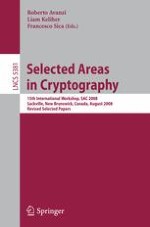2009 | Buch
Selected Areas in Cryptography
15th International Workshop, SAC 2008, Sackville, New Brunswick, Canada, August 14-15, Revised Selected Papers
herausgegeben von: Roberto Maria Avanzi, Liam Keliher, Francesco Sica
Verlag: Springer Berlin Heidelberg
Buchreihe : Lecture Notes in Computer Science
